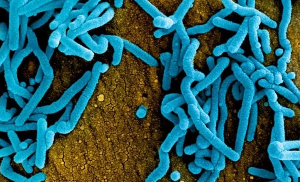Sexual activity comes with risks other than pregnancy. Sexually transmitted diseases (STDs) diseases transmitted from one person to another as a result of sexual contact. Each year about three million teens are infected with an STD. While some STDs are treatable, they have varied effects on people. Some can even cause blindness, deafness, heart disease, brain damage, sterility, and death.
Because of its impact, the most talked-about STD is AIDS. AIDS, or autoimmune deficiency syndrome, is a disease that attacks the immune system. This sysdtem helps the body ward off infection from other diseases, such as pneumonia and cancer. A person with AIDS is infected with a virus (HIV) that is able to destroy the cells of the immune system. Eventually, the immune system fails to protect the body, and the person becomes more and more likely to contact a disease that causes death.
HIV is a delicate virus that is transmitted through blood, semen, vaginal secretions, and breast milk. No evidence exists that it is transmitted through any other body fluids. HIV is acquired when infected body fluid enters directly into the body and reaches the blood of an uninfected person. Sexual activity is the most common method of transmission. During intercose, the virus can enter the blood stream of a person through very small breaks in the skin.
As recently as 1990, there were some regions of the world that had remained relatively unscathed by AIDS. Today, however, there is not a single country around the world which has wholly escaped the AIDS epidemic. As the epidemic has matured, some of the developed nations which were hard hit by the epidemic in the 1980s have reported a slowing in the rate of new infections and a stabilization among existing cases with lower mortality rates and an extension of post-diagnosis lifespan.
However, despite the changing face of the global AIDS pandemic, one factor remains unchanged: no region of the world bears a higher AIDS-related burden than sub-Saharan Africa.Although the sub-Saharan region accounts for just 10% of the world?s population, 67% (22.5 million) of the 33.4 million people living with HIV/AIDS in 1998 were residents of one of the 34 countries of sub-Saharan Africa, and of all AIDS deaths since the epidemic started, 83% have occurred in sub-Saharan Africa . Among children under age 15 living with HIV/AIDS, 90% live in sub-Saharan Africa as do 95% of all AIDS orphans.AIDS has devastated many of the sub-Saharan African economies. The impact of AIDS on the region is such that it is now affecting demographics - changing mortality and fertility rates, reducing lifespan, and ultimately affecting population growth. Although Africa is the region of the world hardest hit by AIDS, and although no country has entirely escaped the virus, prevalence rates vary dramatically between regions, countries, and even within countries.In almost all countries, the HIV/AIDS prevalence rate is significantly higher in urban areas than in rural areas.
Within the general population, the highest prevalence rates are found among the sexually active adult (15 to 49 years old) population. Women tend to get infected at earlier ages than males for a variety of biological and sociocultural reasons. In recent years an intensive government-sponsored HIV prevention campaign focusing on use of condoms and changes in sexual behavior has produced impressive results.Direct economic consequences include the costs of medical care and social programs related to the epidemic while indirect consequences include factors such as dwindling labor productivity as the young, economically productive population takes ill and/or dies. Solving the development problem of the AIDS epidemic in sub-Saharan Africa will require not only massive amounts of foreign aid and expertise, but also a massive social transformation.
Through AIDS-prevention programs aimed at increasing condom use, reducing high-risk sexual behaviors, improving HIV screening, promoting alternatives to breastfeeding, and reducing social stigma associated with AIDS there can be a positive and measurable impact on HIV prevalence or else the Aids Epidemic will continue to claim the lives of millions and millions of Africans.
So, far, there is no cure for AIDS.
Even if pregnancy and disease are avoided, sexual activity can be emotionally harmful to a person. Regrets can cause guilt. New relationships may be harder to form. Reputations can suffer when people don?t take sexual responsibility seriously.



















